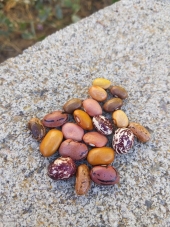













Gray Henon wrote:A lot depends on where you are. Putting a general area in your profile would be very helpful!









Gray Henon wrote:Zone 7 will usually put you square in the transitional zone, which usually comes down to microclimates. Would you say you have mostly fescue/orchard/rye grasses or bermuda/dalis/crab?





Chasing that dream and enjoying every minute of it!
(Usually)









Marty Mitchell wrote:I have found some great lawn care channels on YouTube! I usually look at what they are saying through a permaculture eye. But take timing and temp tips much more seriously. For instance the best time to seed or over seed a lawn is in the Fall. When annuals like crabgrass are checking out and your new grass will not be competing. I just keep the fact that I like clover (because it fixes 3k lbs of nitrogen per acre per year), and perennial wild flowers, etc in the back of my mind.
The best time to plant in the fall (Cool season grasses) is when the soil temps in your area reach 70F. You want the seeds to be germinating when the soil temp hits that point and give it at a minimum 45 days before first Hard Frost. Not mowing the first mow until day 30 and second mow at day 45.
I just bought a spike aerator for my new (mud hole) yard. This will help things like seed, water, air, and fertilizer to more easily get down in there (and stay put!) without washing away. There is a large list of steps I just skipped over. You will have to watch some vids.
There are also some links that you can type to find out your average first and last frost dates... as well as the current and average soil temps for your area. I don't have the links. At work... got to go... Sorry!




Gray Henon wrote:I'd get a soil test done, apply the recommended amount of lime, and overseed with white clover all in the next few weeks. If your soil test shows you are very deficient in P or K, I'd look into a natural source. Recycled clippings and clover will provide all the N necessary. The soil test is key or else you are just guessing.









Gray Henon wrote:In that case, you will need to add the appropriate amount of nitrogen, probably 2x per year, early spring and fall. Keep an eye out for excessive thatch.
















Samer Abraham wrote:
Gray Henon wrote:In that case, you will need to add the appropriate amount of nitrogen, probably 2x per year, early spring and fall. Keep an eye out for excessive thatch.
Ok so here’s what I’ve got so far:
Spring - Nitrogen
Fall - Nitrogen and overseed
Anything else?
Chasing that dream and enjoying every minute of it!
(Usually)

|
We find this kind of rampant individuality very disturbing. But not this tiny ad:
The new permaculture playing cards kickstarter is now live!
https://www.kickstarter.com/projects/paulwheaton/garden-cards
|
